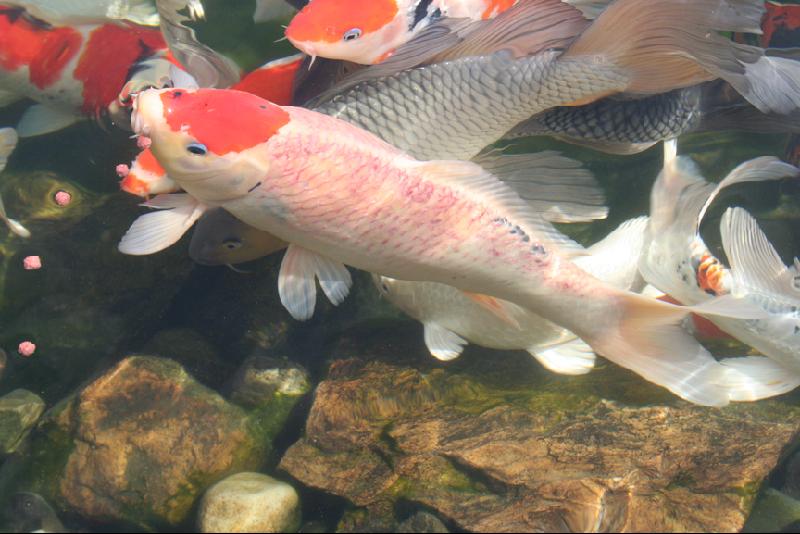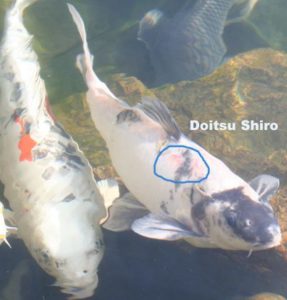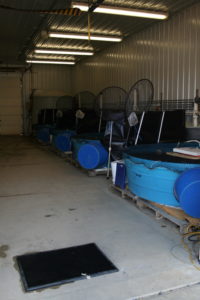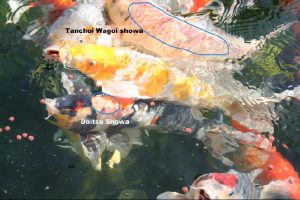Koi Rashes- A Case Study
The Scenario
A few years ago I had a diagnosis problem with some of my breeders that had been recently pulled from the mud ponds. They were in the beginning days of the standard and usual treatment regimen when some of them started getting a mysterious rash. This rash was worsening daily and becoming life threatening. I was pressed to find the answer quickly or I was going to lose some valuable breeders. I had to figure it out! Many people would have instantly blamed this rash on being a “bad reaction” to the treatment chemicals, or from the use of salt and certain treatments together or dosage rates. They would have been wrong! What I eventually discovered has led me to look at diagnosing fish ailments from a whole other perspective. This will also help you whenever you have to figure out what may be wrong with your fish if they have any health issues.
When we pull fish from the mud ponds, they always have parasites to some degree, and we always treat them as quickly as possible after pulling them. However, also when we pull them with the seine nets there is a lot of mud in the nets by the time we finish the pull and start removing the fish. This muddy water in the corralled net causes a liquid sandpaper effect on the fish and can have a detrimental effect on the slime coat. This is especially true in colder water, and this in turn will have a great bearing on not only what we use to treat the fish, but when we begin that treatment regimen after they are pulled from the ponds. Their slime coats are always affected to a degree; it is only the degree that changes from pull to pull. Remember this, as it greatly affects what you are reading.
The following day after pulling them they were scoped and found to have the normal flukes and Trich, but they were pretty infested with both in high numbers. Concerned about the number of parasites, I decided to forgo my normal two day waiting period before treating, and treated the next day after pulling them. They were put into crowded systems and I was concerned about the bugs going crazy in those crowded conditions and causing bigger problems quickly if I did not address the infestation ASAP. It is a normal judgment call we are always faced with in a commercial operation. If the fish have little to no slime coat after pulling them, I like to give them a few days in low salt to help rebuild the slime layer. However, sometimes the bug infestations can be bad, and if we don’t address them in a timely manner, the bugs can do more damage in a short time frame than the risk of treating fish with little to no slime. We will discuss this whole slime coat integrity thing in another article, as this is a critical factor in determining what to use, and when to use it.
These particular fish generally looked and acted very well when I put them into quarantine. This batch was split and put into three separate quarantine systems. Two systems were inside the quarantine building and the third one was a system that was outdoors. Each of these systems firstly got the normal .2% salt solution. We utilize the salt primarily to clam the wild fish, promote slime regeneration, and slow parasite reproduction. Salt no longer kills many bugs, but it does still have its purpose. Now some folks say that salt mixed with certain other treatments causes a “bad reaction” in fish, but we won’t even go into that debate here. We will discuss that myth another time.
When we treat around here, we have a host of primary products we use for protozoans: ProForm C, Quick Cure, PP, as well as a couple we use for flukes; Prazi and Fluke Tabs primarily. There are others as well, but these are the primary ones we utilize. Which one we use for each type of bug depends on a few variables. We will get to that later, but most of it has to do with slime coat integrity at the time of treatment.
In this particular case I used one standard dose of Quick Cure (37% Formalin with malachite green) combo, because it is stronger than ProForm C in solution of both the malachite and the formalin. The reason I chose this treatment was because I wanted to knock down the bugs quickly due to the degree of parasite infestation, as well as the risk of it getting worse in the crowded conditions of the quarantine systems. This treatment was utilized in the exact same dosage rate in each of the three quarantine systems.
During the first treatment in the outside system, the fish flashed quite a bit that afternoon around 5PM. I had put the treatment in at 7AM that morning however. My first thoughts were that it was caused by the treatment itself, as Quick Cure can cause this reaction due to its strength, or it was simply the bugs becoming more active during the treatment and moving around on the fish more as they were reacting to/being killed by the treatment. This flashing reaction can be quite common, so I was not that concerned on that first day. They will usually stop after that first treatment. I did have some thoughts as to something in the water parameters, especially pH (because of the afternoon flashing) but I had checked everything and all was well. I still did not completely rule out water parameters yet, however, as I simply wanted to give it a day before pursuing it further. NEVER rush diagnosing a problem/symptom. The fact that MOST of the fish in only one of three quarantines were flashing is what led me to suspect water/treatment issues over the bugs, but it was too soon to tell, and the water tested fine. The fish in the other two quarantines were flashing only slightly, and only a small percentage of them. Keep in mind that all quarantines concerned with this batch were treated the same each day, and all water parameters were identical in each.
The second day, I did a 90% water change, replenished the salt to .2%, and re-scoped the fish. The Trich were gone/dead, but the flukes remained in force and alive as expected, as Quick Cure will not kill them. The fish continued to flash and more frequently in that one quarantine, and I had more jumping as well. The symptoms were progressing for sure in that one system, but the fish in the other systems were getting better and looking well with little to no symptoms. Again, I suspected the heavy flukes were the culprit of the symptoms, but wondered why the symptoms had increased in only that one system. Again, I was not all that concerned, and wanted another day to see how they would act then. On the third day, I added the Fluke Tabs to address the heavy infestation.
Now, right here I’ll bet some of you are saying “no wonder they are flashing, you are bombarding them with chemicals!” Well, we do it all of the time here, and have very few issues. You have to understand the difference between a commercial operation, as compared to a hobbyist pond of a few fish. We deal in thousands of fish at a time, and most are quarantined in crowded systems due space and economics. This crowding can cause the parasites to multiply quickly and thus do more damage than successive treatments can. In intensive aquaculture we are always forced to pick between the “best” of two evils, and in this case, as usual, we chose to knock back the bugs quickly. We can accept small loses that this may or may not cause, and this is the difference. This is another case of “do as I say not as I do” or…”do not try this at home” type of thing. There is a big difference between how I do things in the commercial world, as compared to what I would suggest a hobbyist do in their ponds. Please understand the difference.
The fourth day in the problem quarantine system showed another increase in flashing and jumping, and now fish were showing signs of reaction of some sort. They were getting a red rash look, and noted to be primarily on their backs only. They were also starting to clamp their fins and sit on the bottom.
I again re-scoped the fish in all systems and found the expected few flukes remaining on the fish in all of the Qt’s concerned. Not near enough to cause these symptoms in this one system. No other bugs were found in any systems of these fish as well.
At this point I did EVERY water test I have, and EVERY system was identical in every respect. At this point I was becoming very concerned as to what was causing this in this one particular system and not in the others. Remember, these are all the same fish from the same pond, and they were all treated identically.
The 5th morning, the fluke tab treatment was finished, and the flukes were gone for the most part. The fish in the problem system were again looking worse, and the redness and other symptoms were increasing! So, I did another 90% water change which I would have done regardless after the Fluke Tab treatment.
On the sixth day, nothing much changed, but here let me note that I realized that the flashing was always worse in the afternoon, as well as the redness on each fishes back. This got me thinking in another direction. Long story short, I realized that this system gets full sun 85% of the day and the other systems do not and are inside or shaded. A light came on in my pea-brain at this moment of realization!
Now I have always preached about noting the fishes’ slime coat integrity before treating with anything. If you treat fish with little to no slime coat, you will most likely have problems with reactions, and even cause deaths, and lessen the chances of a successful treatment. Then the treatments do more damage than the bugs. As discussed above, I knew these fish had little slime coat when going into quarantine, but by the next morning they did have some. In my experience it was enough slime coat to be somewhat assured that the treatment would not affect them. Keep in mind as well, that only one of three systems had these issues, and EVERYTHING was the same amongst them except for SUNSHINE! Two of the three systems were either indoors with no sun or 85% shaded all day long. Only the one system was outdoors, clear water, and 100% sun 85% of the day. Basically put, treating the fish with this little slime coat took them over the edge of what they can handle and allowed the sun’s UV to penetrate and irritate the skin. Another important clue in all this is the only fish that were affected like this were fish that were non-metallic and white. Even upon very close examination, the other colors (even on the same fish) were not affected as badly as the white areas. You can see in the photos below what I mean. There was no discrimination from Doitsu to Wagoi either, only the fact that non-metallic white is more sensitive to the harmful rays of the sun.
Moral is, don’t be so quick to blame the meds…or anything for that matter. Take it one step at a time and you will most likely find the “true” culprit. The slime coat being minimal was the first problem, then the treatments weaken the slime layer further and irritate the skin to a degree as well, but the sun was the primary factor that caused the rash.
Since this occurred a few years ago, I have tested and proven this sunburn condition to be true multiple times now. I have also learned that simply pulling fish from a mud pond that has tinted green water, and then putting them in clear water that is exposed to direct sunlight in itself can be damaging. It makes perfect sense. The fish live most of the time in the water of the mud ponds that sunlight does not penetrate. This in turn leaves their skin more sensitive to direct sunlight when they are exposed to it. So you to can apply this to your own ponds. Many ponds and watergardens go through green water stages at times. If this goes on for extended periods, then the water clears, you may want to consider adding more shade to the ponds to avoid the same issues I have discovered. You would do this shading for a period of time as to let the fishes skin slowly acclimate to the more intensive direct sunlight of the clear water.
Written by John Fornaro, Hanover Koi Farms. ALL RIGHTS RESERVED BY HANOVER KOI FARMS, COPYRIGHT © 2021



